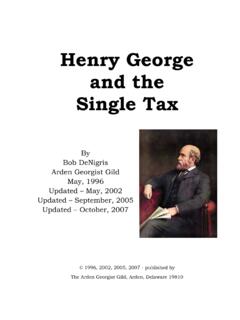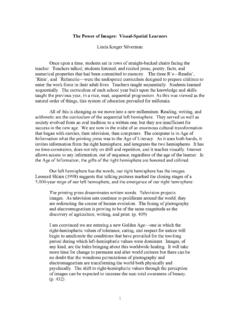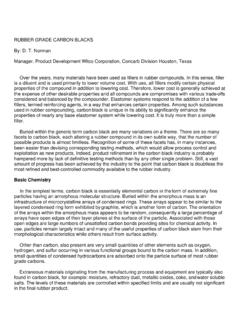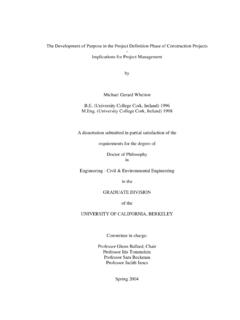Transcription of Progress - Henry George
1 ProgressandPovertyProgressandPovertyWhy there are recessionsand poverty amid plenty and what to do about it! Henry GeorgeEdited and abridgedfor modern readers by Bob DrakeRobert Schalkenbach FoundationHenry GeorgeProgress and PovertyWhy there are recessions, and poverty amid plenty and what to do about it!Edited and abridged for modern readers by Bob DrakeBook and cover design by Lindy DaviesISBN 0-911312-98-6 Library of Congress Control Number: 2006928337 First EditionCopyright 2006 by the Robert Schalkenbach Foundation149 Madison Avenue, Suite 601 New York NY 10016 ContentsPublisher s Foreword by Cliff Cobb .. IXEditor s Preface by Bob Drake ..XIIA uthor s Preface to the Fourth Edition ..XVIntroduction: The Problem of Poverty Amid 1 First Part: Wages and Capital1. Why Traditional Theories of Wages are Wrong .. 82. Defining Terms .. 173. Wages Are Produced By Labor, Not Drawn 284.
2 Workers Not Supported By Capital .. 415. The True Functions of Capital .. 46 Second Part: Population and Subsistence6. The Theory of Population According to Malthus .. 517. Malthus vs. Facts .. 578. Malthus vs. Analogies .. 699. Malthusian Theory Disproved .. 75 Third Part: The Laws of Distribution10. Necessary Relation of the Laws of 8311. The Law Of Rent .. 8912. The Cause of Interest .. 9513. False Interest .. 10214. The Law Of Interest .. 10615. The Law Of Wages .. 11116. Correlating The Laws of Distribution .. 12017. The Problem Explained .. 123 Fourth Part: The Effect of Material Progresson the Distribution of Wealth18. Dynamic Forces Not Yet Explored .. 12619. Population Growth and Distribution of Wealth .. 12820. Technology and the Distribution of Wealth .. 13721. Speculation .. 142 Fifth Part: The Problem Solved22. The Root Cause of Recessions .. 14523. The Persistence of PovertyDespite Increasing Wealth.
3 155 Sixth Part: The Remedy24. Ineffective Remedies .. 16525. The True Remedy .. 180 Seventh Part: Justice of the Remedy26. The Injustice of Private Property In Land .. 18227. The Enslavement of Labor .. 19228. Are Landowners Entitled to Compensation? .. 19829. History of Land as Private Property .. 20330. History of Property in Land in the US .. 211 Eighth Part: Application of the Remedy31. Private Property in Land is Inconsistentwith the Best Use of Land .. 21932. Securing Equal Rights To Land .. 22333. The Canons of Taxation .. 22634. Endorsements And Objections .. 236 Ninth Part: Effects of the Remedy35. The Effect on Production .. 24236. The Effect on The Distribution of Wealth .. 24637. The Effect on Individuals and Classes .. 25038. Changes in Society .. 254 Tenth Part: The Law of Human Progress39. The Cause of Human Progress .. 26340. Differences in Civilizations .. 27041.
4 The Law of Human Progress .. 27542. How Modern Civilization May Decline .. 28743. The Central Truth .. 29544. Conclusion: The Individual Life .. 300 Afterword: Who Was Henry George ?by Agnes George de .. 311 Publisher s Foreword IXPublisher s ForewordWE OWE Bob Drake a debt of gratitude for this meticu-lous condensation and modernization of Henry George sgreat work. The original version had an elegance thatevoked a passion for social justice among millions of read-ers in the nineteenth and early twentieth centuries. How-ever, by the beginning of the twenty-first century, George scomplex prose stood in the way of that intention for largenumbers of people. Now his ideas can once again be widelyaccessible. What were those ideas and why are they still impor-tant today? When Progress and Poverty was published in1879, it was aimed in part at discrediting Social Darwin-ism, the idea that survival of the fittest should serve as asocial philosophy.
5 That ideology, developed by HerbertSpencer, William Graham Sumner, and others, providedthe intellectual basis for 1) American imperialism againstMexico and the Philippines, 2) tax policies designed toreduce burdens on the rich by shifting them onto the poorand middle class, 3) the ascendancy of the concept of ab-solute property rights, unmitigated by any social claimson property, 4) welfare programs that treat the poor asfailures and misfits, 5) racial segregation in education andhousing, and 6) eugenics programs to promote the supe-rior race. The intellectual defense of racism is in abey-ance, but the economic and political instruments ofdomination have changed little. The renewed defense ofX Progress and Povertytaxing wages and consumer goods rather than propertyholdings, expanded intellectual property rights, and vastimperial ambitions are indications that Social Darwinismis back in full revival of Social Darwinism continues to justifysocial disparities on the basis of natural superiority orfitness.
6 Progress and Poverty, by contrast, reveals that thosedisparities derive from special privileges. Many econo-mists and politicians foster the illusion that great for-tunes and poverty stem from the presence or absence ofindividual skill and risk-taking. Henry George , by con-trast, showed that the wealth gap occurs because a fewpeople are allowed to monopolize natural opportunitiesand deny them to others. If we deprived social elites ofthose monopolies, the whole facade of their greater fit-ness would come tumbling down. George did not advo-cate equality of income, the forcible redistribution ofwealth, or government management of the economy. Hesimply believed that in a society not burdened by thedemands of a privileged elite, a full and satisfying lifewould be attainable by George is best remembered as an advocate ofthe single tax on location values.
7 (I say location ratherthan land to avoid the common confusion that Georgewas primarily interested in rural land. In fact his attentionwas focused on the tens of trillions of dollars worth ofurban land that derives its value from location.) Yet, forGeorge, wise tax policy was merely a vehicle to break thestranglehold of speculative ownership that effectively limitsthe opportunity to earn an decent living and participate inpublic the image that best captures George s ultimateintention is the final scene in a popular science fictionPublisher s Foreword XIfilm, when the hero is able to restore the oxygen supplyto the surface of a planet so that people will no longer beenslaved by the man holding the oxygen monopoly. Free-ing people from the oppression of monopoly power inany form was Henry George s great dream. Those whohave conceived of George as being concerned only withtax policy should closely read the last third of Progressand Poverty, which reveals his larger vision of justice andgenuine and Poverty stands the test of time.
8 It con-tains profound economic analysis, penetrating social phi-losophy, and a practical guide to public policy. Those whoread it today will find in George s work a great source ofvision and Cobb, Program DirectorRobert Schalkenbach FoundationXII Progress and PovertyEditor s PrefaceTHOSE WHO FIRST pick up this book are likely to sharesome concern about the problem of poverty; those whofinish it may also find some cause for hope. For the greatgift that Henry George gave the world was a systematicexplanation logical and consistent of why wealth is notdistributed fairly among those who produce it. But he didnot stop there he also gave us a simple yet far-reachingplan for a cure. It was, and still is, a plan for peace, pros-perity, equality, and and Poverty is an enduring classic. It has beentranslated into dozens of languages; millions of copies havebeen distributed , then, the need for a modern edition, and anabridged one at that?
9 Simply put, Henry George , likemany late-19th century authors, wrote in a style thatmodern readers may find unduly complex. As editor, Ihave endeavored to break long and intricate sentencesinto shorter ones, creating what I call a thought-by-thought translation. Furthermore, references to history, mythology, and lit-erature that do not advance the central argument have beenremoved. Gender-balanced language has also been incor-porated. However, I have not attempted to update finan-cial statistics or technological prepared this edition in two distinct stages: modern-ization and condensation. I have sought to ensure thatEditor s Preface XIII nothing of substance was left modernizing the text, I reduced the average sen-tence length and increased the number of sentences. Sen-tences were shortened by about one-third. For example,one passage showed a decline in average sentence lengthfrom twenty-eight words to nineteen words.
10 By compari-son, the average sentence in Time magazine was fifteenwords in 1974, perhaps fewer simplifying language, I reduced the number of syl-lables per hundred words by about ten percent, to syllables per word. The number of sentences per hun-dred words was increased by fifty combined effect of these changes transformed thetext from one comprehensible to only a small fraction ofthe population to one that can be easily read by a high-school senior. An early test I performed showed that stu-dents were able to read the modernized text abouttwenty-five percent faster than the original, even beforecondensation. Although no formal testing for comprehen-sion was done, anecdotal reports indicate that comprehen-sion was greatly the second stage, I condensed the modernized textby rewriting sentences using simpler language, removingmultiple examples where one would suffice, and generallyediting for brevity.










